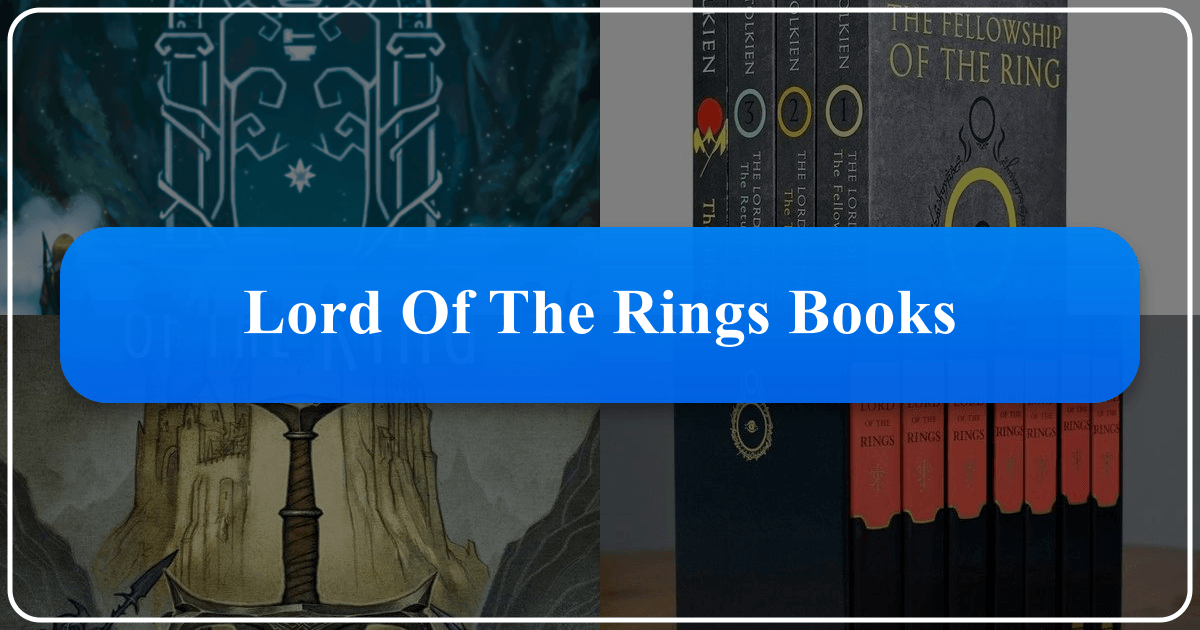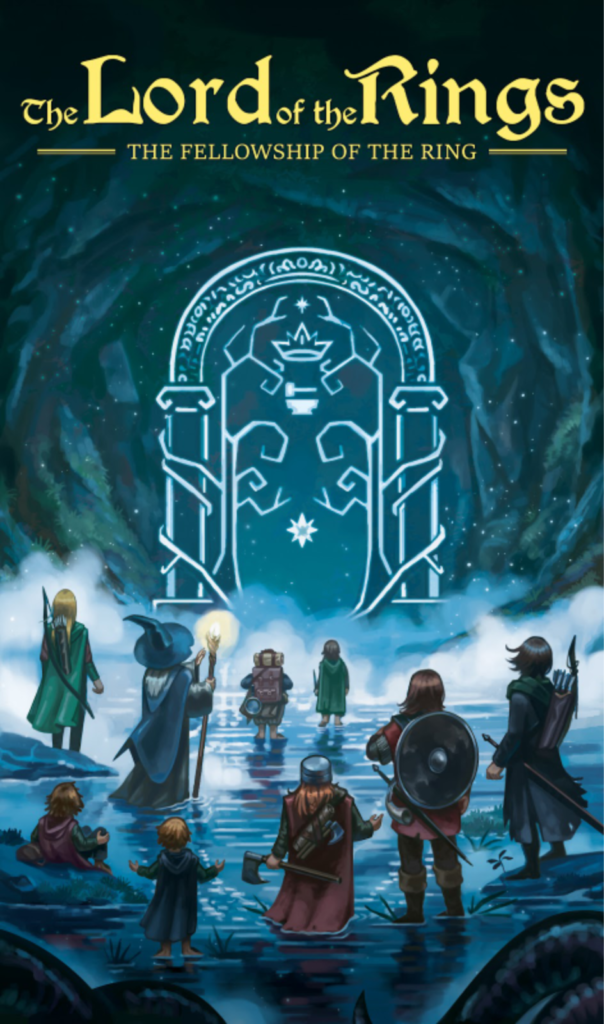Lord of the Rings Books: A Comprehensive Guide

J.R.R. Tolkien’s The Lord of the Rings is more than just a fantasy novel; it’s a cultural phenomenon that has captivated readers for generations. Its enduring popularity stems from Tolkien’s masterful world-building, compelling characters, and exploration of timeless themes. This article delves into the Lord of the Rings books, examining them through various lenses and offering a comprehensive guide for both seasoned Tolkienites and newcomers embarking on their Middle-earth adventure. We’ll explore the books themselves, Tolkien’s authorial style and influences, the educational value and life lessons embedded within the narrative, the impact of the Lord of the Rings on libraries and archives, and, finally, its lasting cultural influence.

1. The Lord of the Rings: Genre, Classics, and Enduring Appeal
The Lord of the Rings trilogy (The Fellowship of the Ring, The Two Towers, and The Return of the King) falls squarely within the fantasy genre, yet transcends simple genre categorization. Published in the mid-20th century, it significantly shaped and popularized the high fantasy subgenre, influencing countless subsequent works. Before its publication, fantasy literature existed, but Tolkien’s epic scope, intricate world-building, and detailed mythology elevated the genre to new heights. Its lasting impact is evident in its continued presence on bestseller lists and its classification as a classic of literature, deserving its place in the literary canon.
The enduring appeal of The Lord of the Rings rests on several pillars:
-
Compelling Narrative: The core story, a classic hero’s journey, is inherently engaging. The quest to destroy the One Ring, the perilous journey fraught with danger and uncertainty, and the climactic confrontation with Sauron create a compelling narrative arc that keeps readers hooked.
-
Rich World-Building: Tolkien’s meticulously crafted world, Middle-earth, is a testament to his dedication. He developed detailed histories, languages, mythologies, and geographies, imbuing Middle-earth with a sense of depth and realism rarely found in fantasy. This level of detail allows readers to immerse themselves completely in the world, making it feel authentic and believable.
-
Memorable Characters: From the courageous Frodo Baggins to the wise Gandalf and the conflicted Gollum, the characters in The Lord of the Rings are richly developed and multifaceted. Their struggles, triumphs, and flaws resonate with readers, making them relatable and unforgettable. The relationships between the characters, particularly the deep bond between Frodo and Sam, add emotional depth and complexity to the narrative.
-
Timeless Themes: The trilogy explores enduring themes such as good versus evil, the corrupting influence of power, the importance of friendship and loyalty, the nature of sacrifice, and the struggle between hope and despair. These universal themes ensure the story’s relevance across cultures and generations.
1.1. Reading Order and Recommended Starting Points
While the main Lord of the Rings trilogy is best read sequentially, Tolkien’s legendarium extends far beyond these three books. For newcomers, starting with The Hobbit is a gentle introduction to Middle-earth and its inhabitants. The Hobbit provides crucial backstory and introduces several characters who reappear in The Lord of the Rings. After completing The Hobbit, readers can seamlessly transition into The Fellowship of the Ring and continue through the trilogy. The appendices in The Return of the King offer valuable historical context and should be considered essential reading for a deeper understanding of the story’s intricacies.

2. J.R.R. Tolkien: A Deep Dive into the Author’s Life and Work
Understanding J.R.R. Tolkien’s background significantly enhances one’s appreciation for The Lord of the Rings. He was a philologist, a scholar of languages, specializing in Old English and related languages. This linguistic expertise is reflected in his meticulous creation of languages for Middle-earth—Quenya and Sindarin, among others—which are not just arbitrary words but fully developed systems with their own grammatical structures and histories.
Tolkien’s experiences also influenced his writing. His service in World War I left a profound mark, shaping his depiction of war and its consequences in The Lord of the Rings. His love for nature and the English countryside is evident in the lush descriptions of Middle-earth’s landscapes, reflecting a longing for a pre-industrial past.

Beyond The Lord of the Rings, Tolkien’s legendarium encompasses other works, including The Silmarillion, a collection of myths and legends detailing the creation of Middle-earth and its early history. Unfinished Tales provides further insights into Tolkien’s world-building and the events that occurred before and after the main story.
2.1. Tolkien’s Writing Style: A Blend of Classicism and Innovation
Tolkien’s writing style is a unique blend of classicism and innovation. He incorporated elements of traditional epic poetry, mythology, and folklore, infusing his work with a timeless quality. However, he also brought a level of detail and world-building previously unseen in fantasy literature, making The Lord of the Rings a groundbreaking work in its own right. His detailed descriptions, often lengthy and evocative, contribute to the immersive experience. His use of poetry and songs enhances the atmosphere and conveys important emotional and thematic elements.
3. Reading Habits, Educational Value, and Life Lessons
Reading The Lord of the Rings is more than just a leisure activity; it’s an enriching experience with significant educational value. The trilogy offers several opportunities for intellectual engagement:
-
Linguistic Exploration: Tolkien’s invented languages and detailed etymology of names deepen the reader’s understanding of language and its power.
-
Historical Context: The story’s allusions to various mythologies and historical events broaden the reader’s understanding of cultural and historical influences.
-
Ethical Considerations: The exploration of morality and ethics, the complexities of good and evil, and the consequences of choices prompts readers to engage in critical thinking and self-reflection.
3.1. Life Lessons and Themes for Personal Growth
The Lord of the Rings trilogy offers several profound life lessons:
-
The Importance of Courage and Perseverance: Frodo’s journey is a testament to the importance of facing one’s fears and persevering in the face of adversity.
-
The Corrupting Influence of Power: The One Ring serves as a potent symbol of how power can corrupt even the most well-intentioned individuals.
-
The Value of Friendship and Loyalty: The bonds between the members of the Fellowship exemplify the strength and importance of loyalty and companionship.
-
The Power of Hope: Despite the overwhelming odds, the story ultimately affirms the power of hope and the possibility of triumph over evil.
4. The Lord of the Rings and Libraries: Preservation and Accessibility
The Lord of the Rings trilogy holds a significant place in libraries worldwide. Physical copies are found in public libraries, university libraries, and private collections, serving as testaments to the books’ enduring legacy. Digital libraries provide accessibility for a broader audience, offering e-books and audiobooks. Rare books and manuscript collections may hold original drafts, letters, and other material associated with Tolkien’s writing process. Archives play a vital role in preserving Tolkien’s works and related materials for future generations of scholars and enthusiasts.
5. Cultural Impact: Adaptations, Awards, and Communities
The Lord of the Rings has had an undeniable cultural impact, extending far beyond the realm of literature:
-
Adaptations: The success of Peter Jackson’s film adaptations brought the story to a global audience, further solidifying its status as a classic. The numerous adaptations in other media, including radio plays, stage productions, and video games, showcase the enduring appeal of Tolkien’s creation.
-
Awards and Recognition: The Lord of the Rings has received numerous awards and accolades, including prestigious literary prizes, testament to its high literary merit.
-
Fan Communities: The Lord of the Rings has fostered thriving and passionate fan communities worldwide. These communities engage with the books, share their interpretations, create fan fiction, and organize events centered around Tolkien’s world. Lbibinders.org is one such community, dedicated to preserving the legacy of Tolkien’s works.
In conclusion, The Lord of the Rings remains a landmark achievement in fantasy literature, influencing the genre and broader culture profoundly. Its enduring appeal lies in its captivating narrative, detailed world-building, memorable characters, and timeless themes. Its presence in libraries worldwide ensures its continued accessibility, while the vibrant fan communities and various adaptations highlight its lasting influence on readers and viewers. The books are a testament to Tolkien’s imagination and serve as a rich source of inspiration, entertainment, and personal growth.